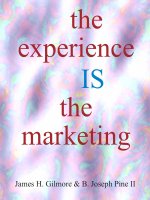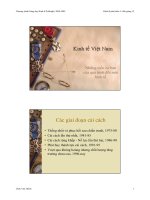Kiến thức kinh tế - Marketing1
Bạn đang xem bản rút gọn của tài liệu. Xem và tải ngay bản đầy đủ của tài liệu tại đây (177.57 KB, 14 trang )
Copyright 2002 by Strategic Horizons LLP • Page 1
the
experience
IS
the
marketing
James H. Gilmore & B. Joseph Pine II
Copyright 2002 by Strategic Horizons LLP • Page 2
O
ne of AOL Time Warner’s last acts of
2001 was announcing that it would close
all 85 of its Warner Bros. Stores, while
one of the Walt Disney Company’s first acts of
2002 was its own announcement of closing another
50 Disney Stores (for a total of 120 in the past
year). Then in March, amidst continued
disappointing sales, Disney decided to split its
remaining studio stores into two distinct formats
– Disney Play aimed at kids, and Disney Kids at
Home aimed at their parents.
What happened? How could these titans of media
and marketing – especially with all the beloved
cartoon characters featured so prominently within
their stores – fail so miserably at retailing? (Disney
even finds the going so difficult it now looks to
double its trouble.) We believe the problem stems
from the very concept of retail “store.” Instead of
stores, AOL Time Warner and the Walt Disney
Company should have leveraged their vast
knowledge of their theme park, movie, music, and
online businesses to create retail experiences.
Consider a competitor in the toy business, The
Pleasant Company, maker of the American Girl
collection of dolls. When founder and ex-
schoolteacher Pleasant Rowland decided to go
beyond selling her wares directly to consumers,
rather than open a store she produced an
experience: The American Girl Place, just off
Michigan Avenue in Chicago. Here, mothers and
daughters (with not a few grandmothers) spend
time together at The American Girl Theater, where
for $25 apiece they can take in a 70-minute staged
production, The American Girls Revue. They go
to The Cafe for a “grown-up dining experience,”
paying an admission fee of $16 for lunch or tea
and $18 for dinner. Girls pose for a $21.95 photo
shoot to take home a copy of American Girl
Magazine with their pictures on the cover. They
The Experience
IS the Marketing
James H. Gilmore
B. Joseph Pine II
Copyright 2002 by Strategic Horizons LLP • Page 3
even have their dolls’ hair styled in The Hair Salon
for $10 (a simple ponytail) to $20 (restoring the
look of its original styling).
Think about it: A family can walk into the
American Girl Place and spend hundreds of dollars
– without buying a thing! Of course, each one
arrives home with more dolls, more furniture,
more clothing, and more accessories as
memorabilia of their experiences. This Place so
engages guests that visits average over four hours
To be clear, we’re not talking about “experiential
marketing” – making your marketing promotions
more experiential. That’s all well and good, but
as yet another adjective-based idea it only affects
marketing materials around the edges. We are
talking about a fundamentally new way of
attracting and retaining your customers through
creating new experience offerings. It’s not about
experience marketing, but rather marketing
experiences. As Peter Drucker rightly articulated
– and you know the more time they
spend, the more money they spend. The
American Girl Place achieves this level
of retail success precisely because it has
so thoroughly abandoned the “store”
paradigm. (Proof? The question visitors
already inside the Place most frequently
ask of the concierge in the foyer is,
“Where’s the store?”).
Marketing Experiences
The Pleasant Company, since bought by Mattel,
understands a fundamental dictum for creating
demand today: The experience IS the marketing.
The best way to market any offering (good, service,
or experience) is with an experience so engaging
that potential customers can’t help but pay
attention – and pay up.
We see many companies today floundering in how
to market their offerings thanks to the demise of
mass markets, the ineffectiveness (and un-
measurability) of advertising, and the seeming
failure of using the World Wide Web as an effective
marketing vehicle. That’s why we also see a
plethora of “adjective-based” marketing ideas; to
name just a few, think of guerilla marketing,
permission marketing, viral marketing, even
emotion marketing and emotional marketing. Each
type may have something valuable to say, but never
really addresses the heart of the problem: People
have become relatively immune to messages
targeted at them. The way to reach your customers
is to create an experience within them.
in The Practice of Management, “The aim of
marketing is to make selling superfluous.” To that
we add: The aim of experiences is to make
marketing superfluous.
Making Marketing Superfluous
For this to work, it’s crucial that the experiences
you create be treated as distinct economic
offerings – not as a marketing exercise alone –
that engage your customers and create memories
within them. A great place to start, especially for
manufacturers, is to follow The Pleasant
Company’s lead: Establish a flagship venue.
Implementing this principle, automaker
Volkswagen created a destination attraction called
Autostadt from unused land outside its factory in
Wolfsburg, Germany. Guests experience each of
its eight brands in ways the company, for the first
time, can fully control. Brewer Heineken
fashioned the Heineken Experience inside its old
factory in downtown Amsterdam, where guests
get to be a beer bottle traveling along an assembly
line (complete with being filled to the brim with a
cold one!). And last year General Mills opened
up Cereal Adventure at the Mall of America in
People have become relatively
immune to messages targeted at them.
The way to reach your customers is
to create an experience within them.
Copyright 2002 by Strategic Horizons LLP • Page 4
Minnesota, where kids go on tours and play games
to learn all about how cereal is made (and can even
leave with their own picture on a box of Wheaties).
Even B2B, or business-to-business, companies are
getting into the act. Case Construction Equipment
created the Case Tomahawk Experience Center
in the northwoods of its home state of Wisconsin
to provide an outdoor arena for potential customers
to try out its large earth-moving gear in a low-
key, relaxed atmosphere before they buy. (Folks
often have so much fun playing with the equipment
that they stay for several nights.) Not surprisingly,
Case found that due to the relationships created
there, a trip to Tomahawk dramatically increases
its close rates.
Indeed, Executive Briefing Centers really are
flagship venues that businesses place inside of
their offices to turn mundane customer visits into
engaging experiences. At the Johnson Controls
Showcase in Milwaukee, the company plunges
customers into an inky, cold darkness to simulate
a winter outage – or bakes them in an arid heat
wave – to demonstrate viscerally how its
technology helps potential customers avoid the
trauma of such occurrences. At Nortel Network’s
Executive Briefing Center in Research Triangle
Park, North Carolina, guests receive smart cards
Tellingly, the money for such corporate
experiences – as well as the consumer-oriented
Autostadt and Heineken Experience – comes
out of each company’s marketing and/or
communications budgets. Indeed, let’s cement this
principle: Steal from traditional marketing. As
a start, carve out 20% of your traditional PR and
advertising budgets and put it into the realm of
physical experiences. Such experiences engender
emotional connections with which no marketing
messages can hope to compete. Indeed, while
many still do, a number of experience stagers
manage to forego completely or do very little
traditional advertising. The Pleasant Company,
Starbucks, the World Famous Pike Place Fish
Market, Vans, Recreational Equipment, Inc., and
a host of others choose to let their experiences
alone serve the purpose of acquiring new
customers and energizing old ones.
As a corollary, realize too: Use your creative
resources as your R&D. Don’t view your internal
marketing talent or your external agencies as
resources solely to be wasted on mere marketing
campaigns, but as the very designers of your best
economic offerings: the experiences that drive
demand for your company. When it comes to
experiences, it’s not your father’s R&D. The same
folks back in the lab designing your physical goods
or in the field developing your new service
offerings are unlikely to have the necessary back-
that activate and guide their experience with Nortel
technology. Potential customers find themselves
immersed in personalized presentations that use
the latest in experience technologies (including
virtual reality) to demonstrate how the latest in
Nortel technologies would apply directly to them.
ground or skills to design and script, much
less construct and cast, an experience.
Think of some of the highly imaginative
advertisements of the past few years.
What if we unleashed all that creativity
on conceiving, designing, and bringing to
market revenue-generating – and profit-
enhancing – experiences? Instead of just
creating those wonderful youth-dancing
commercials for the Gap, what if its ad agency
were contracted to conceive, design, and rollout –
in other words, innovate! – a compelling dance
club where kids pay to gyrate in their jeans? (And
perhaps others pay to watch on the Web?) What if
Nike’s incredibly creative talent were used not just
to put those basketball-passing, sneaker-
Don’t view your internal marketing
talent or your external agencies as
resources solely to be wasted on mere
marketing campaigns.
Copyright 2002 by Strategic Horizons LLP • Page 5
squeaking, breath-exhaling commercials on the air,
but to design real basketball courts that customers
actually used in their Niketown stores? In other
words, don’t just show it, do it! Do this to establish
ongoing businesses, not temporary campaigns.
in the stores feed people directly to the website
while online presentations feed people to the
company’s stores. (It leaves you wondering why
Amazon.com doesn’t do the reverse, creating a
physical flagship in the hometown it shares with
Expanding Your Portfolio
And don’t stop at just one experience – you should
create a series of related experiences that flow one
from another, creating demand up and down at
every level, both generating new forms of revenue
and driving sales of whatever you currently offer.
In other words: Create a rich portfolio of
experiences.
Outdoor retailer Recreational Equipment, Inc.
(REI), for example, created a flagship experience
in its hometown of Seattle, complete with a
climbing mountain (for which non-members pay
a $5 fee) as well as a bicycle track, walking trails,
and other such experiences. This flagship realized
such success that it became the number one tourist
attraction in all of Seattle, with more than two
million visitors per year. So REI added a second
layer of similar experience venues at other locales,
including one in Minnesota that fashioned a cross-
country ski trail around the place, and one next to
a river in Denver with a kayaking experience. REI
expands its portfolio through its 50-plus retail
environments that, while recognized as “stores”
by the buying public, still yield a heightened
experience via their architecture and ambience,
as well as through the various educational classes
and clinics held there. A further member of REI’s
experience portfolio is its website, REI.com, that
is effectively integrated into its retail channel. PCs
REI.)
Vans Inc., the forty-year-old manufacturer
of athletic shoes particularly popular with
skateboarders, grinders, and other extreme
sports enthusiasts, developed a different
kind of experience portfolio. While athletic
retailers always carried its shoes, Vans early
on created its own retail environments – the
strength of its brand voiding potential
channel conflict for its now 140-plus locales –
providing a distinctive shopping experience that
it could stage. But it finally hits its experience
stride in 1998 when the company opened up its
first Vans Skatepark in The Block at Orange, a
mall in Southern California. There, kids pay $7 to
$14 for two-hour skateboarding sessions in,
around, and above ramps, jumps, and combi-pools.
Vans now has ten Skateparks around the country,
with the latest adding indoor/outdoor BMX biking
tracks.
None, however, qualify as a flagship.
Appropriately for a company whose customers zip
around on skateboards, Vans produced a mobile
flagship: the Vans Warped Tour, which goes to
some twenty-plus cities every year. More than an
alternative rock concert for alternative athletes,
this new genre of experience combines a music
festival with skateboarding spectacle. Filling out
its portfolio even further, the company created
Vans Triple Crown sporting events to give its
customers a nationally televised experience as
their own show (not a nationally televised
commercial interrupting somebody else’s show).
It also stages Skateboard and Snowboard Camps
for aspiring enthusiasts at its Skateparks and other
venues, and like REI, effectively integrates its
website into its experience portfolio.
Through the practice of companies such as these,
we’ve been able to divine a full Location
Don’t stop at just one experience
— you should create a series of
related experiences that flow one
from another….








